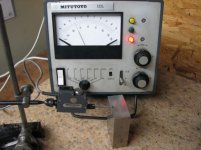Bill in PA
Hot Rolled
- Joined
- Jan 25, 2011
- Location
- Fairfield, PA
Follow along with the video below to see how to install our site as a web app on your home screen.
Note: This feature may not be available in some browsers.





I have a very similar unit. If the three lights respond to the probe displacement, the device is probably working OK with only the meter stuck. This is usually caused ether by a tiny steel cutting caught in the meter magnet and blocking the coil movement. Can be carefully removed with tweezers once the meter is opened. I had this problem and it is common in a machine shop where ferrous metals are machined.
The other cause of stuck meter can be the result of impact. Often this tangles the hair-spring. This too is easy to fix.
Broken pivots, dead meter coil, etc. are difficult to repair. Might be easier to replace the meter itself. Most are 100 or 250 micro-amp meters. You can find an inexpensive (or free) old meter and fit it in the instrument. The term is "Panel Meter".
Good luck!
View attachment 141109
When the power is OFF and input probes disconnected, does the needle move when the unit is rocked from side to side?
BTW, I recommend removing foreign objects that get lodged between the armature and magnet by using a narrow strip of cellophane tape held with a pair of tweezers. The tape will go into places the tweezers can't, is not attracted by the magnet and is less likely to cause damage.

The needle has moved from handling the unit. It was closer to zero when I first got it.
Bill
 )
)That's an indication the meter movement is binding somewhere: needle rubbing on scale; foreign material between armature and central or peripheral magnet poles; or a tangled (overlapped) spring as BillZweig suggested.The needle has moved from handling the unit. It was closer to zero when I first got it.
Notice
This website or its third-party tools process personal data (e.g. browsing data or IP addresses) and use cookies or other identifiers, which are necessary for its functioning and required to achieve the purposes illustrated in the cookie policy. To learn more, please refer to the cookie policy. In case of sale of your personal information, you may opt out by sending us an email via our Contact Us page. To find out more about the categories of personal information collected and the purposes for which such information will be used, please refer to our privacy policy. You accept the use of cookies or other identifiers by closing or dismissing this notice, by scrolling this page, by clicking a link or button or by continuing to browse otherwise.
